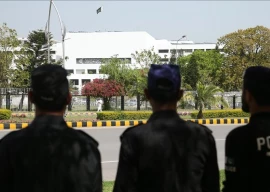
The Free and Fair Election Network (Fafen) has called upon the Election Commission of Pakistan (ECP) to strictly ensure the principle of equality of population among electoral constituencies in the fresh delimitation exercise, initiated as a result of the official publication of 7th Population and Housing Census-2023.
According to a statement issued by Fafen on Sunday, the delimitation process follows the recent amendments to the Elections Act, 2017, including the insertion of a new proviso to Section 20 (3), that now does not require the ECP to “strictly adhere” to the existing district boundaries if doing so causes the variance in population of constituencies of an assembly to surpass 10 per cent.
“Such measures are necessary to strengthen the fairness of the election process as required under Article 218 (3) of the Constitution,” the statement said, adding that the unequal size of constituencies also violated the spirit of the constitutionally guaranteed equality of citizens before the law (Article 25).
Fafen was of the view that the new proviso neutralised the requirement as carried out in Section 20 (1) that compelled the ECP to regard the existing boundaries of administrative units, among other principles, in delimiting electoral constituencies previously. “It will also minimise the executive’s influence on the delimitation process, which previously may do so by creating or redefining the boundaries of an existing administrative unit.”
Read also: Fresh delimitation vital for true representation: ECP
The strict adherence to the district boundaries during the delimitation of the national and provincial assembly constituencies completed in 2022, Fafen said, resulted in 82 NA and 88 PA constituencies having a population varying by more than 10 per cent from the respective quotas per seat ie average population of a constituency for each province, as calculated under Rules 8 (1) and 8 (4) of the Election Rules, 2017.
The NA constituencies with more than 10 per cent population variation included 34 constituencies in Punjab, 22 in Khyber-Pakhtunkhwa, 23 in Sindh and three in Balochistan. The PA constituencies included 30 in K-P, 28 in Balochistan, 18 in Sindh and 12 in Punjab. The largest NA constituency NA-39 Bannu having a population of 1,210,183 was nearly three times bigger than the smallest constituency NA-42 Tank having a population of 427,044. For the PAs, the largest constituency of Balochistan Assembly PB-3 Killa Saifullah (342,932) had around three times more population than PB-23 Awaran (121,821); the largest of K-P Assembly PK-108 Tank (427,044) had 2.5 times more population than the smallest PK-1 Upper Chitral (169,297); the largest of Punjab Assembly PP-83 Khushab-II (444,166) had 1.3 times more population than the smallest PP-93 Chiniot-I (324,878); and, the largest of Sindh Assembly PS-34 Naushehro Feroze-II (436,288) had 1.3 times more population than the smallest PS-80 Jamshoro-I (315,390).
Fafen estimated that the population variance of NA constituencies from their respective regional quotas may exceed 10 per cent in case of constituencies of two-thirds of K-P districts, half of Sindh districts, and one-third of Punjab districts and all of Balochistan districts if district boundaries are to be respected as was the previous practice.
Fafen recommended that the ECP may consider amending its rules on the delimitation of constituencies to materialise the spirit of the newly added proviso to Section 20 (3). Specifically, Fafen recommended amending Rules 10 (4) and 10 (5) for limiting population variance to a maximum of 10 per cent within a province instead of five per cent within a district. Additionally, in the interest of electoral transparency, the “ECP must also add a column in Form-7 (Final List of Constituencies) to provide an updated population of final constituencies after the disposal of representations filed on the draft list of constituencies”.
“Delimitation is one of the most critical mechanisms of allocation of political power to people by the state, and therefore, must be just, fair, and transparent.























COMMENTS
Comments are moderated and generally will be posted if they are on-topic and not abusive.
For more information, please see our Comments FAQ